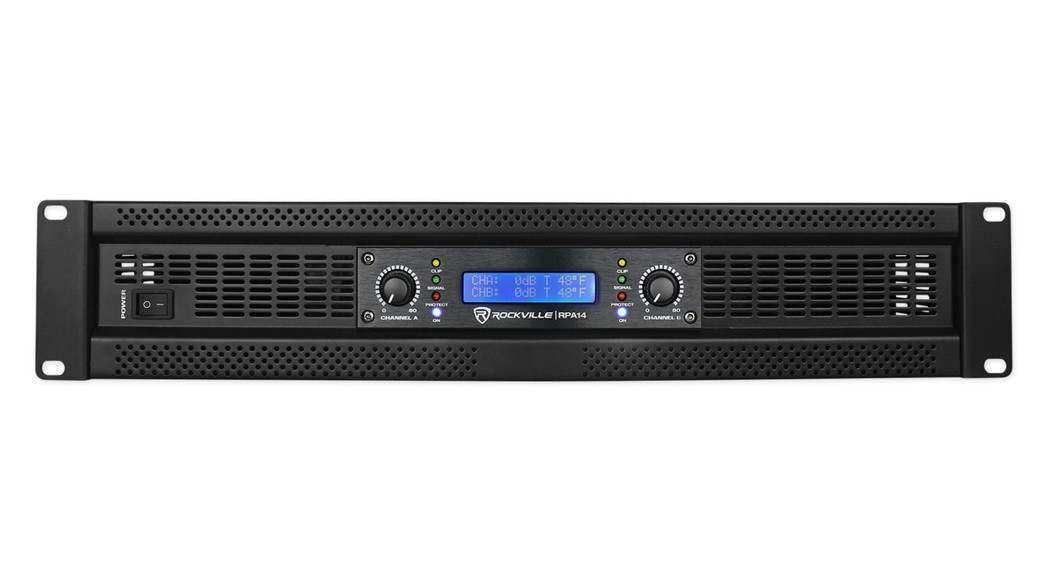
0147000-WATT PRO RACK AMPLIFIEROWNER’S MANUAL
WHO READS MANUALS?
 Instead, go to vimeo.com/509741235 or scan the QR code and watch a short video that shows you how to set this item up and how to use it.If you prefer written instructions, please read ahead!With Rockville, you get many options. Instead, go to vimeo.com/509741235 or scan the QR code and watch a short video that shows you how to set this item up and how to use it.If you prefer written instructions, please read ahead!With Rockville, you get many options. |
Missing items? If you ordered a bundle that includes more than one product and you are missing part of your bundle, then it just means your order shipped from two different warehouses. You will receive the remaining items very soon. If you have any concerns or inquiries, feel free to call our customer support center at 1-646-758-0144, Monday through Thursday, 9 am to 10 pm EST, and Fridays, 9 am to 3 pm EST.
Thank you for purchasing this Rockville product. Please read this installation guide carefully for proper use of your Rockville D14 Pro Amplifier. Should you need assistance, please call our technical helpline at 1-646-758-0144, Monday through Thursday, 9 am to 10 pm EST, and Fridays, 9 am to 3 pm EST.
IMPORTANT SAFETY INSTRUCTIONS

TO REDUCE THE RISK OF ELECTRICAL SHOCK, NEVER OPEN THE UNIT. THERE ARE NO SERVICEABLE PARTS INSIDE. WE RECOMMEND TAKING THE UNIT TO A QUALIFIED SERVICE TECHNICIAN FOR ANY REPAIRS.
- Do not expose this unit to any kind of moisture.
- Please ensure that the unit is situated in a properly ventilated area.
- Make sure cooling fan vents are free of obstructions.
- Replace the fuse with one of the same type, size, and rating only.
- Do not attempt to operate this unit if the power cord has been frayed or broken.
- Do not attempt to break off or remove the ground prong. This prong is used to reduce the risk of electrical shock and fire in case of an internal short.
- Do not operate this unit if it is damaged.
- This unit is intended for indoor use only.
- Always mount this unit in a safe and stable manner.
- Power supply cords should be routed so that they are not likely to be walked on or pinched by items placed on or against them, paying particular attention to the point of exit from the unit.
- To avoid unnecessary wear and to improve the unit’s lifespan, unplug the unit when not in use for extended periods of time
Features
- LCD Screen: Displays signal level and temperature for each channel.
- Channel A Signal Level Adjustment Knob: Controls the level of the incoming signal. The actual voltage attenuation of the amplifier is shown in Turn the knob counterclockwise if the Clip LED remains on for more than 5 seconds (indicating the input signal is too strong).
- Channel A LEDs:Clip – Indicates that the amplifier’s output is within 3dB of clipping. Occasional blinking is acceptable, but if it remains on for more than 5 seconds, you should turn down the level controls or reduce the output level of the input source to avoid audible distortion.Signal – Indicates that there is an input signal greater than 100mV.Protect – Indicates that the output connection is shorted, the load impedance is too low, or there is an internal malfunction.
- Power LED: Indicates the power is turned on.
- Channel B LEDs: See item 3 above.
- Channel B Signal Level Adjustment Knob: See item 2 above.
- Power On/Off Switch

|
7. Channel A/B Speakon outputs8. Bridged Speakon output9. Channel A/B XLR /1/4″ TRS/TS combo inputs10. Mode switch: stereo or bridged/parallel11.80Hz Low Pass Filter on/off switch |
Setup
Rack Mounting
The D14 was designed for standard 19″ rack mounting and requires a 1.5U rack space. Use the included screws and washers to mount the amp to the front rack rail. Preferably, the sidewall should be at least 2″ from the sides of the amplifier and the back of the rack should be open. This will ensure a source of cool air to all sides. Be sure to support the rear of the amp, especially for mobile use during which it will be subjected to strong vibrations. These amps can also be “stack” mounted without a cabinet.
Configurations
Crossover and Mode Switches

Configurations (continued) Stereo
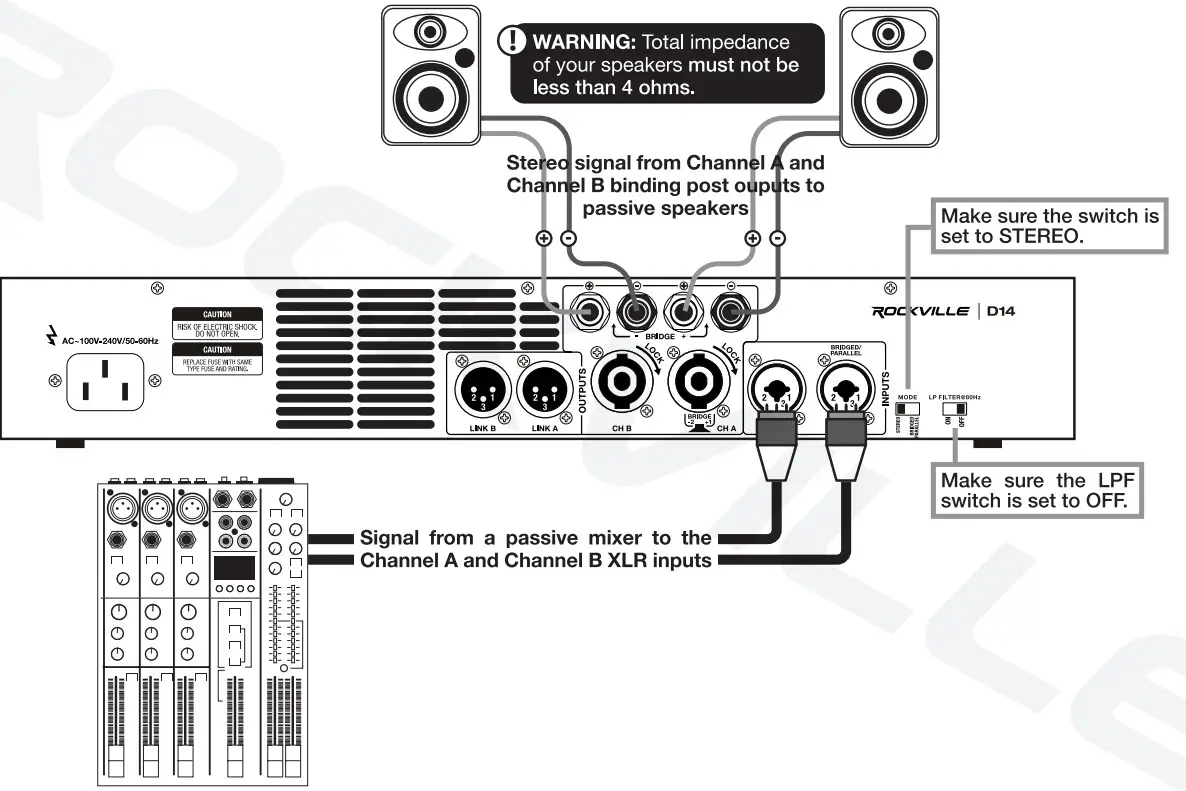
Parallel (mono to speakers via Speakon)
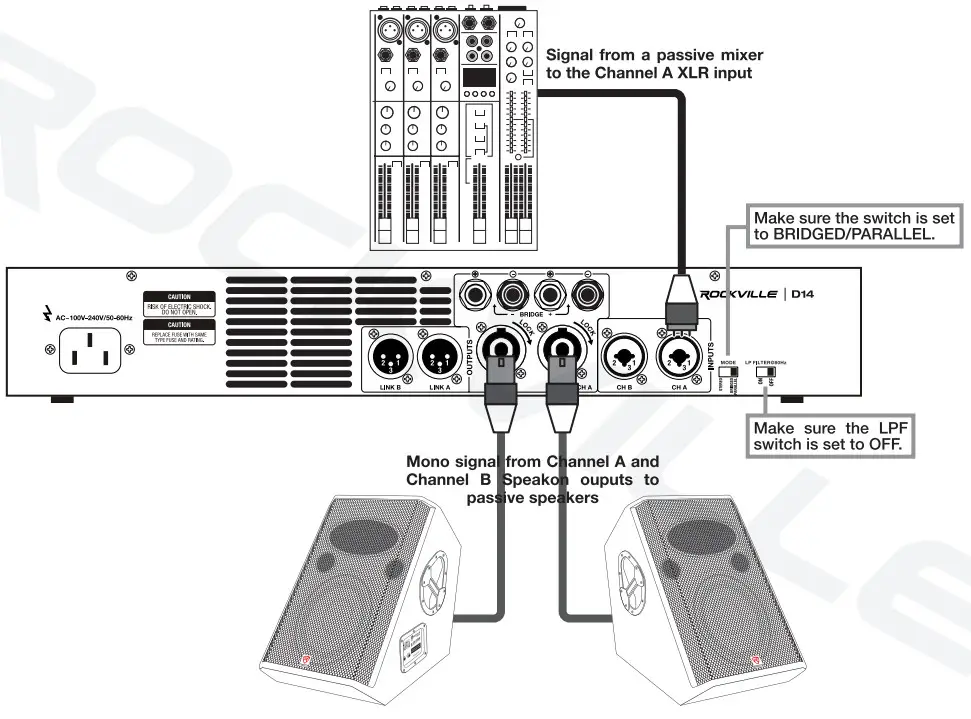
Parallel (mono to speakers via binding posts)
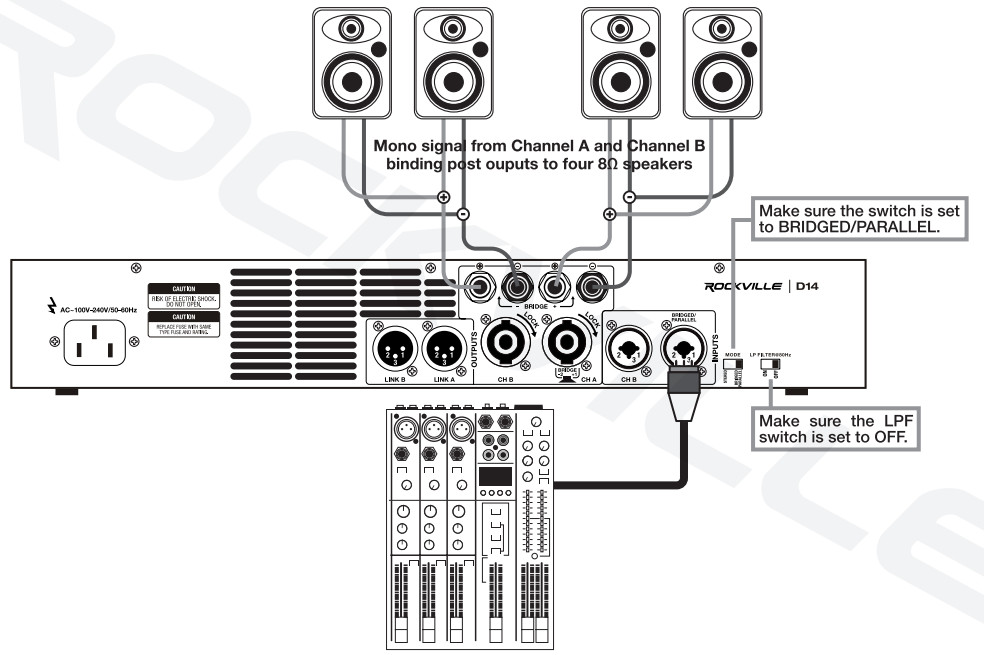
Parallel (mono to subwoofers)
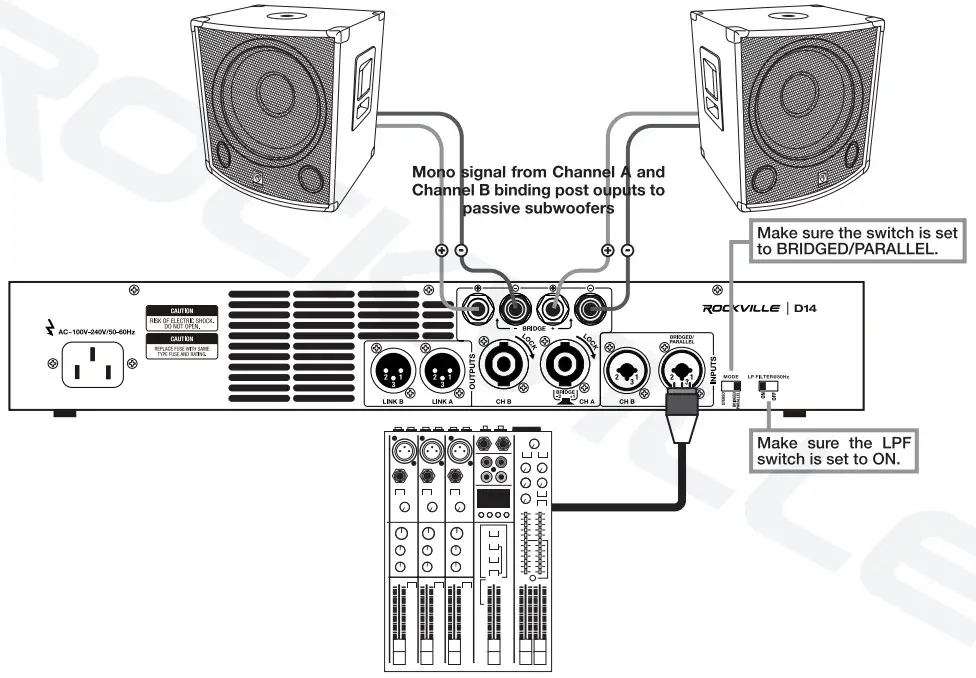
Bridged(mono)
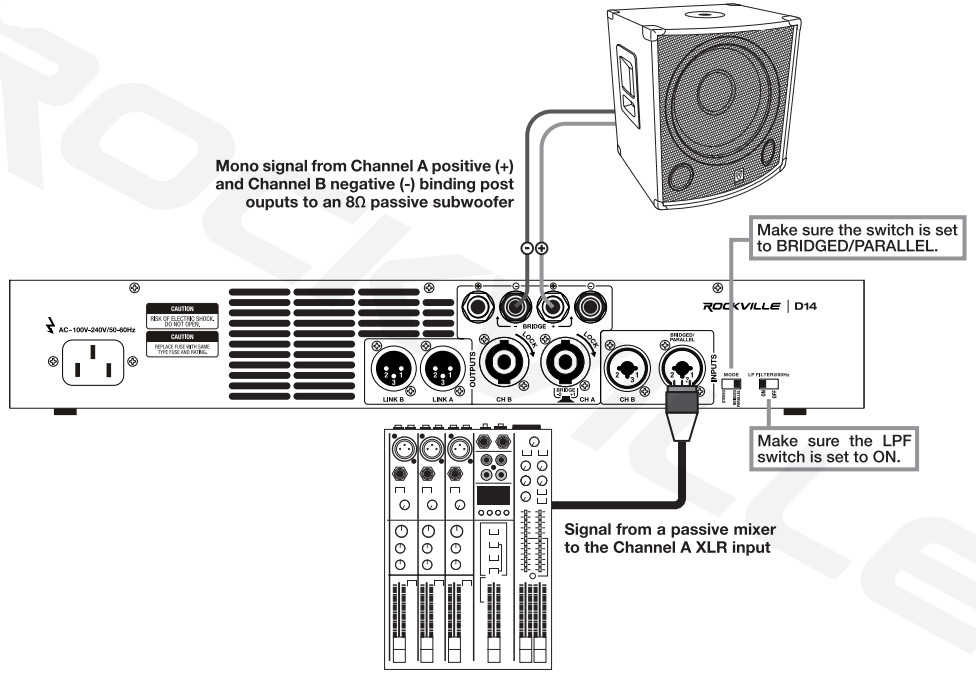
Link Out XLRThese setups allow you to use the amplifier’s XLR Link outputs to send the full-range signal from the main amp to a secondary amp (Diagram A) as shown below, directly to a powered sub (Diagram B on page 12), or to a pair of powered PA speakers (Diagram C, page 12).DIAGRAM A
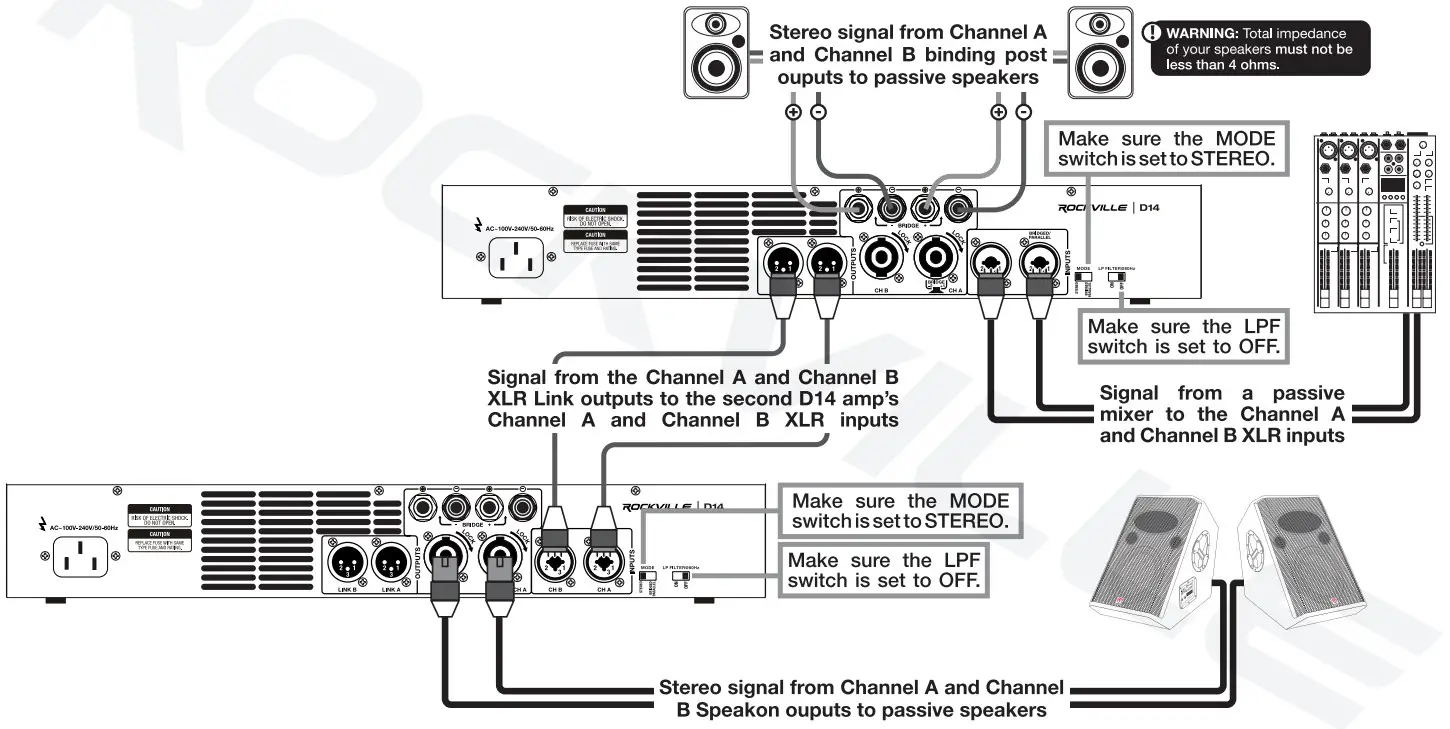
Link Out XLR
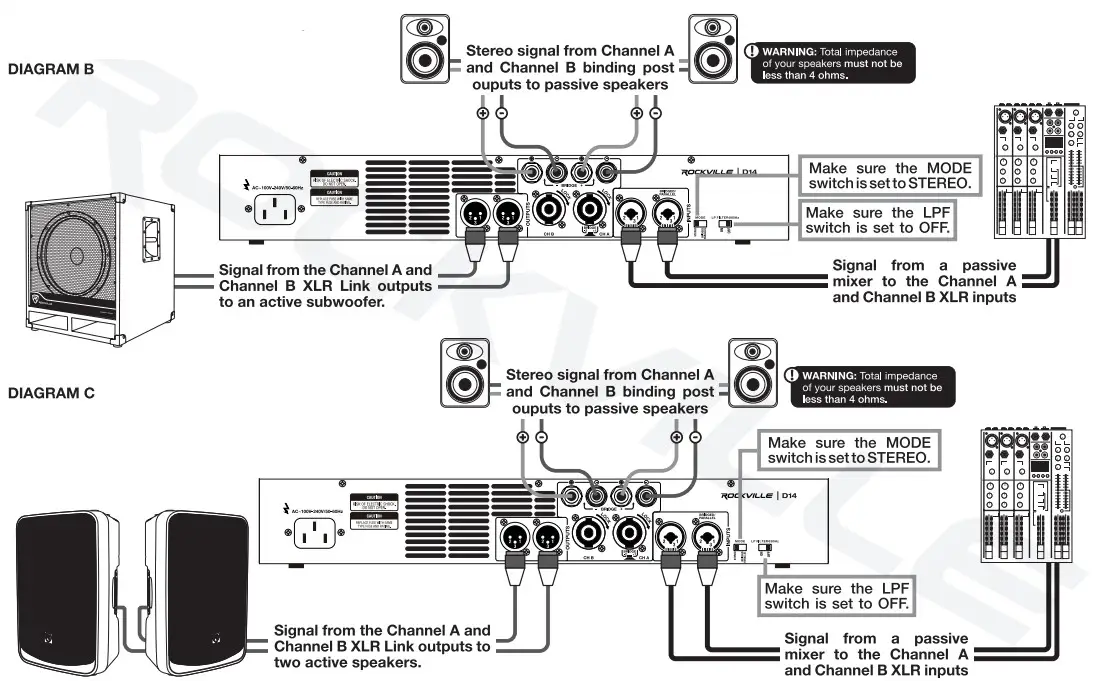
Features/Specifications
- RMS Power Output: Stereo 8 Ohm: 2 x 700WStereo 4 Ohm: 2 x 1000WBridged 8 Ohm: 1 x 2000W
- Peak Power Output: Stereo 4 Ohm: 2 x 3500W MaxBridged 8 Ohm: 1 x 7000W Max
- Rockville D14 Class D 2-Channel Power Amplifier
- LCD displays volume in dB per channel and operating temperature
- 5U rack space
- Built-in limiter protects your speakers from distortion and clipping
- Stereo mode is perfect for two or four speakers in a left/right configuration
- Bridged/Parallel mode allows you to combine both channel’s power into one channel for use with a subwoofer (bridged) or gives you a dual mono output signal, which is perfect for monitor use when you want all sounds coming out of each speaker instead of a UR configuration
- Built-in 80Hz Low Pass Filter (with on/off switch) allows the amp to be used with full-range PA speakers (off) or subwoofer(s) (on)
- Channel A & B individual power, signal, clipping, and protection LED indicators on the front of the amp
- Channel A & B individual level controls for precise setting and matching of sensitivity
- Heavy-duty rack mount ears
- Built-in variable high-velocity quiet cooling fans
- Maximum headroom for 4-ohm and 8-ohm speakers
- Computer-controlled IC protection circuit protects against speaker short circuit, thermal overload, and DC overload
- Frequency Response (bandwidth @ 2Vrms out, @ -3.0dB) 10Hz — 30Khz
- THD + Noise @ 1Khz full power: <0.18%
- Input Impedance: 10K Ohm Balanced
- Input signal voltage: 640mV — 2.7V
- Input sensitivity: 0.7v
- Damping factor (100Hz, 10w, 4 ohms): 44.1
- Damping factor: (1Khz @ 8 ohm): >400:1
- Effective damping factor (100Hz, 10w, 4 ohms): 1.08
- Output impedance at speaker terminals: 0.0901 Ohms
- Frequency Response vs THD+N (worst case, across normal bandwidth 1W) 0.09%
- Signal to Noise Ratio: >100dB
- SLEW RATE (input filter limited): 28v/uS
- Power Requirements: 100V – 240V/50 – 60Hz
- Weight: 9.9Lbs
- Dimensions: 19.09″ x x 2.56″
Terminals
- Input Terminals:Combo jack (XLR and 1/4″) A & B inputs
- Output Terminals:
A & B Banana binding post speaker outputsA & B Speakon outputsA & B XLR Link outputs to connect another amplifier or powered sub
Troubleshooting
| PROBLEM | SOLUTION |
| No power | 1. Make sure the unit is plugged in and the power switch is in the ON position.2. Check that the power cable is properly plugged into the wall socket.3. If people or equipment tend to step on and roll over or stretch your power cable, it can get damaged. Check the power cable for damage. If the cable is damaged, discontinue using the unit until the cable can be repaired. |
| No sound | 1. Check that all appropriate cables and wires are plugged incorrectly.2. Check the channel level settings.3. Check the volume settings on your input devices.4. Check mixer’s master and input volumes.5. Make sure you are using the proper cables.6. Make sure speakers are connected to the amp’s OUTPUT, not INPUT.7. Make sure the mixer is connected to the amp’s INPUT, not OUTPUT8. Make sure the mixer’s mute isn’t on. |
| The clipping light is on | 1. Turn down signal level controls (gain).2. Check the impedance of speakers or subs. |

![]()
RockvilleAudio.com2021 ROCKVILLE // Features and specifications are subject to change and/or improvement without notice.
[xyz-ips snippet=”download-snippet”]

